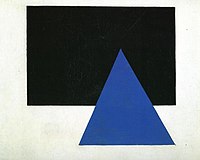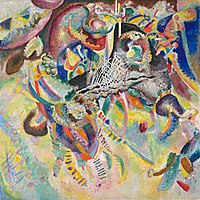Our website is made possible by displaying online advertisements to our visitors.
Please consider supporting us by disabling your ad blocker.
Abstract art



Abstract art is modern art which does not represent images of our everyday world. It has colour, lines and shapes (form), but they are not intended to represent objects or living things. Often the artists were influenced by ideas and philosophies of abstraction.[1]
Abstract art is found in painting and in sculpture. There are also many works of art which are partly abstract, and partly representational. Many artists worked in abstract and other types of modern art.
Purely abstract art is a 20th-century invention. It grew out of the earlier forms of modern art, but it is perhaps the one movement which is absolutely modern. It has no roots in earlier art (as we use the term today).[2]
Abstract art challenges viewers to interpret and engage with the artwork on an emotional or intellectual level, rather than focusing on realistic representation.
- ↑ Gooding, Mel 2000. Abstract art. Tate Publishing, London. ISBN 1854373021
- ↑ Just possibly some prehistoric art might be counted. Islamic decorative tiles in early mosques might be a candidate.
Previous Page Next Page


